Step into the ancient world of Greece and witness the architectural and engineering marvels that have stood the test of time. From the grandeur of the Acropolis in Athens to the sacred sanctuary of Delphi and the awe-inspiring Olympia, each structure tells a story of ingenuity, craftsmanship, and artistic excellence. Explore the development and key characteristics of Greek architecture, marvel at the perfection of the Parthenon, and discover the elegance and innovation of the Erechtheion. Journey to Delphi and be captivated by the divine feat that is the Temple of Apollo and the convergence of art and history in the Theater of Delphi. Pay tribute to the gods at Olympia with the majestic Temple of Zeus and bear witness to the triumphs of ancient athletes at the Stadium of Olympia. Uncover the ancient legacy of Minoan architecture with the unearthed majesty of the Palace of Knossos and the architectural enigma of the Phaistos Disc. Step back in time and immerse yourself in the captivating wonders of Ancient Greece.
Contents
- 1. Greek Architecture: A Brief Overview
- 2. The Acropolis: The Grandeur of Athens
- 3. Delphi: The Oracle’s Sacred Sanctuary
- 4. Olympia: A Tribute to the Gods
- 5. Minoan Architecture: Crete’s Ancient Legacy
- Conclusion
-
Frequently Asked Questions
- 1. What are the key characteristics of Greek architecture?
- 2. What are the three orders of Greek architecture?
- 3. What materials were commonly used in Greek architecture?
- 4. How did Greek architecture influence later architectural styles?
- 5. What is the significance of the Parthenon?
- 6. How were the ancient Greek temples constructed?
- 7. What is the role of the phaistos disc in Greek architecture?
- 8. How did Greek architects achieve perfect precision in their structures?
- 9. Which Greek architectural marvel is associated with the Oracle of Delphi?
- 10. What is the lasting legacy of Greek architecture?
- References
-
Frequently Asked Questions
- 1. What were the main influences on ancient Greek architecture?
- 2. How were the materials for Greek architecture sourced?
- 3. What is the significance of the columns in Greek architecture?
- 4. How were the architectural proportions determined in ancient Greece?
- 5. What made the Parthenon an architectural symbol of perfection?
- 6. How did the Oracle of Delphi influence the architecture in Delphi?
- 7. What is the significance of the Temple of Zeus in Olympia?
- 8. How did Minoan architecture differ from other ancient Greek architecture?
- 9. What do we know about the Phaistos Disc and its architectural significance?
- 10. How did ancient Greek architecture influence contemporary architectural styles?
- References
- Read More
1. Greek Architecture: A Brief Overview
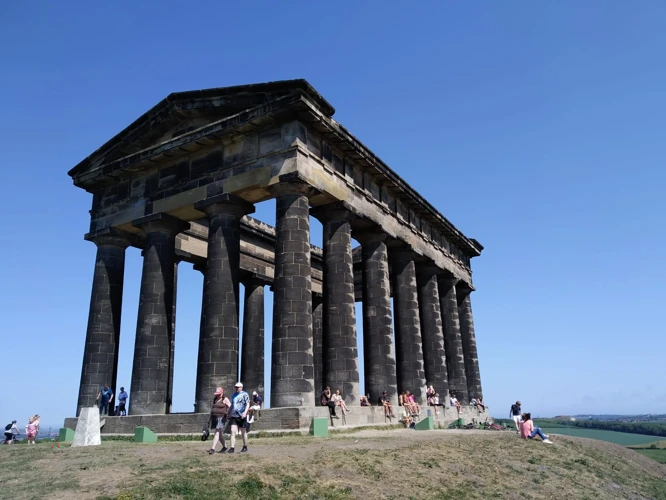
Greek architecture is renowned for its timeless beauty and influential designs that have shaped the course of architectural history. It emerged during the Archaic period (800-480 BC) and reached its zenith during the Classical period (480-323 BC). The architecture of ancient Greece is characterized by a harmonious blend of aesthetic and structural elements, showcasing meticulous attention to detail and a deep appreciation for proportion and balance. Greek architecture can be broadly categorized into three orders: Doric, Ionic, and Corinthian, each with its distinctive features and proportions. The Doric order is known for its simplicity and solidity, featuring sturdy columns with no base and a capital topped with a plain slab called an abacus. The Ionic order, on the other hand, is more ornate and delicate, characterized by slender columns with distinctive scroll-shaped capitals known as volutes. Finally, the Corinthian order is the most elaborate and decorative, featuring columns adorned with intricate acanthus leaves. Greek architecture also incorporated essential architectural elements such as the entablature, frieze, pediment, and cornice, which added a sense of grandeur and refinement to the structures. The legacy of Greek architecture can still be seen in many modern buildings and continues to inspire architects and designers around the world.
1.1 The Development of Greek Architecture
The development of Greek architecture can be traced back to the Archaic period, which marked the beginning of monumental construction in Greece. During this period, simple structures made of wood and mud-brick evolved into more sophisticated stone buildings. The Greeks were influenced by the architectural traditions of ancient Egypt and Mesopotamia but infused their own distinctive style and design principles. One of the key advancements was the introduction of the stone column, which provided structural support and became an essential element of Greek architecture. The Doric order was the first architectural style to emerge and was prevalent in mainland Greece. As the Greeks expanded their influence across the Mediterranean, they adopted the Ionic order, which featured more slender columns with intricate capitals. The development of Greek architecture coincided with the rise of city-states, which created a competitive atmosphere that fostered architectural advancements. The architects and builders of ancient Greece constantly sought to push the boundaries of design and engineering, resulting in increasingly complex and innovative structures. The construction of temples and sanctuaries played a significant role in the development of Greek architecture, serving as religious and cultural centers that showcased the wealth and power of the city-states. It is through this relentless drive for architectural excellence that Greece produced some of the most iconic and enduring structures in history.
1.2 Key Characteristics of Greek Architecture
When it comes to Greek architecture, several key characteristics set it apart and make it truly remarkable. These characteristics not only showcase the ingenuity of the ancient Greeks but also influenced architectural styles throughout history.
1. Symmetry: Greek architecture is known for its strict adherence to symmetry, both in overall form and in the details. This focus on balance and proportion creates a sense of harmony and aesthetic appeal.
2. Columns: The use of columns is a defining aspect of Greek architecture. The three main orders – Doric, Ionic, and Corinthian – each have their own distinct column design, contributing to the overall style of the structure.
3. Frieze and Pediments: The frieze, a decorative band, and the pediments, triangular gables, were commonly used in Greek architecture to add ornamentation and tell stories through sculptures and reliefs.
4. Peristyle: Many Greek buildings feature a peristyle, a colonnaded porch or courtyard that surrounds the main structure. This architectural element creates a sense of grandeur and provides shade and shelter.
5. Geometric Proportions: Greek architects employed mathematical principles and geometric proportions, such as the Golden Ratio, to achieve balance and visual harmony in their designs.
6. Integration with Surroundings: Greek architecture often harmonized with the natural landscape, with structures built on hills or cliffs and incorporating the surrounding environment into the design.
These key characteristics, among others, are what make Greek architecture enduring and influential. It continues to captivate and inspire architects, historians, and enthusiasts around the world today
2. The Acropolis: The Grandeur of Athens
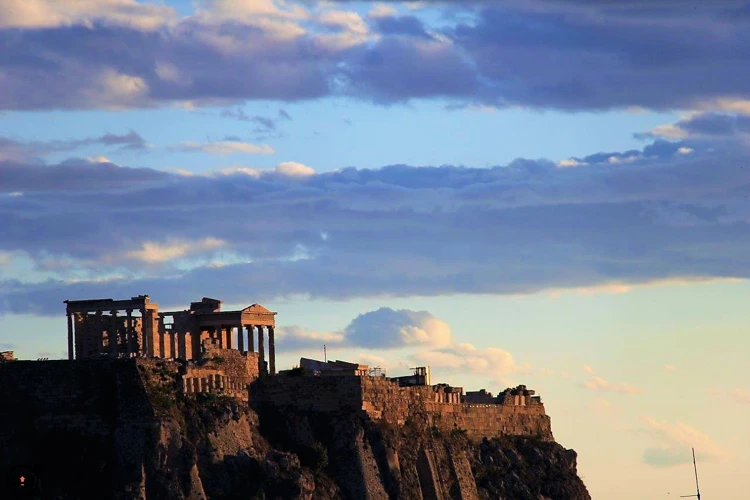
The Acropolis stands proudly atop a rocky outcrop in the city of Athens, embodying the grandeur and magnificence of ancient Greek architecture. This iconic UNESCO World Heritage Site was once the heart of the city-state and served as a symbol of power and cultural achievement. The most prominent structure within the Acropolis is the Parthenon, dedicated to the goddess Athena, the patron deity of Athens. The Parthenon showcases the epitome of Doric architecture with its imposing columns, intricate friezes, and intricate metopes. It is a true testament to the skill and craftsmanship of the ancient Greeks. Another remarkable structure on the Acropolis is the Erechtheion, characterized by its unique design and innovative features. The porch of the Maidens, adorned with six Caryatid statues, is a highlight of this temple. These statues, depicting young women, serve as architectural support, showcasing the ingenuity of Greek architects. The Propylaea, the monumental gateway to the Acropolis, completes the architectural ensemble, with its impressive marble staircase and grand entrance. Exploring the Acropolis is like stepping back in time, where every corner whispers tales of architectural brilliance and the rich history of ancient Athens. To truly appreciate the grandeur of the Acropolis, one must witness the interplay of light and shadow on the magnificent marble structures while marveling at the breathtaking panoramic views of the city below.
2.1 The Parthenon: A Symbol of Perfection
The Parthenon stands as one of the most iconic architectural achievements of ancient Greece. This majestic temple, located on the Athenian Acropolis, was built between 447 and 432 BC as a dedication to the goddess Athena. Designed by the renowned architects Ictinus and Callicrates, and overseen by the sculptor Phidias, the Parthenon is a testament to the perfection of Greek architecture. The temple is constructed in the Doric order and exhibits exceptional craftsmanship and meticulous attention to detail. Its unparalleled symmetrical design and exquisite proportions create a sense of harmony and balance that is captivating. The Parthenon’s exterior is adorned with intricate friezes and metopes depicting legendary battles and mythical stories. Perhaps the most impressive feature is the massive statue of Athena Parthenos that once resided within the temple. The Parthenon’s enduring legacy lies in its enduring influence on Western architecture and its embodiment of Greek ideals of beauty, wisdom, and artistic excellence. To better understand the significance of the Parthenon, it is essential to delve into the historical and cultural context of ancient Greece.
2.2 The Erechtheion: A Blend of Elegance and Innovation
The Erechtheion is a remarkable example of Greek architecture, known for its blend of elegance and innovation. Located on the Acropolis in Athens, this ancient temple was constructed in the 5th century BC and served as a sanctuary dedicated to various gods and heroes. The design of the Erechtheion stands out for its asymmetrical layout, a departure from the typical symmetrical temple designs of the time. The temple is divided into two sections, each with its distinct architectural elements. The east end features the famous “Porch of the Maidens,” also known as the Caryatids. These six intricately carved female figures serve as columns, supporting the roof of the porch and adding a touch of grace and femininity to the structure. Four of the original Caryatids are now housed in the Acropolis Museum, while replicas stand in their place on the Erechtheion. Another notable feature of the Erechtheion is the Porch of the Kore, which showcases exquisite Ionic columns and a stunning frieze depicting mythical scenes. The temple is also home to the sacred Olive Tree of Athena, a symbol of peace and prosperity. The innovative nature of the Erechtheion is evident in its unique design choices and the incorporation of multiple cults and worship spaces within a single structure. It stands as a testament to the creative genius of ancient Greek architects and continues to inspire awe and admiration to this day.
2.3 The Propylaea: The Gateway to the Acropolis
The Propylaea is a remarkable architectural masterpiece that serves as the grand entrance to the Acropolis in Athens. Designed by the renowned architect Mnesicles, this monumental gateway was constructed between 437 and 432 BC. The purpose of the Propylaea was not only to provide access to the Acropolis but also to create a sense of awe and anticipation for visitors as they approached the sacred site. The Propylaea consists of a central building with two projecting wings, creating a grand entrance adorned with Doric and Ionic columns. The central building features a large marble staircase leading to the monumental gateway, which was originally flanked by statues of the goddess Athena and Nike, the winged goddess of victory. The columns of the Propylaea are meticulously crafted, exhibiting the Doric order on the exterior and the Ionic order within the central hall. The use of these different orders in a single structure showcases the architectural prowess of the ancient Greeks. The Propylaea also features intricately carved friezes and pediments, depicting various mythological scenes and events. Despite being unfinished due to the outbreak of war, the Propylaea remains an imposing structure that captures the grandeur and elegance of ancient Greek architecture. Today, visitors can still walk through this magnificent gateway to access the Acropolis and experience the awe-inspiring beauty of the ancient citadel. It serves as a testament to the architectural genius and enduring legacy of the ancient Greeks.
3. Delphi: The Oracle’s Sacred Sanctuary
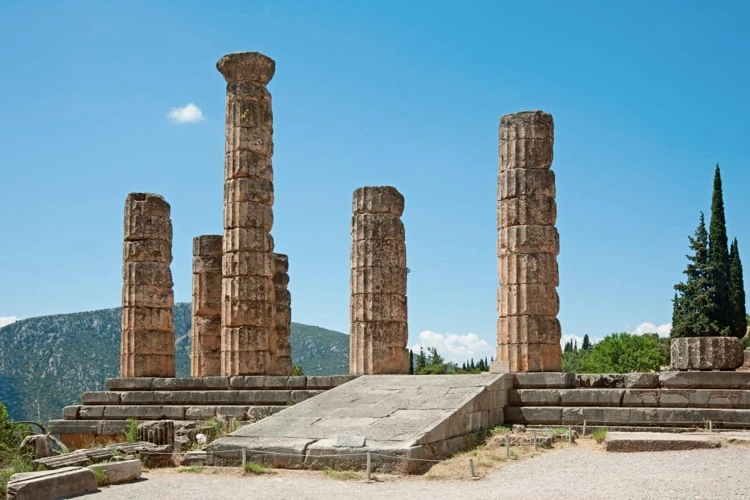
Delphi, located in central Greece, was a sacred sanctuary and an important religious site in ancient times. It was believed to be the center of the world, and its oracle was renowned for its prophecies and wisdom. The most prominent architectural feature in Delphi is the Temple of Apollo, dedicated to the god of light, music, and prophecy. This divine structure stood proudly on the slopes of Mount Parnassus, surrounded by stunning natural scenery. The temple was built in the Doric order, known for its simplicity and solidity. It featured a colonnaded facade with rows of sturdy columns, supporting an entablature and pediment. According to legend, the Oracle of Delphi would receive messages from Apollo, providing advice, predictions, and guidance to supplicants from all corners of the ancient world. The theater of Delphi, another remarkable architectural marvel, was a place where art and history converged. It offered a mesmerizing setting for dramatic performances, musical events, and religious ceremonies. The theater was built into the natural slope of the mountain, showcasing exceptional acoustic properties and offering breathtaking views of the surrounding landscape. The combination of precise architectural design and the mesmerizing natural backdrop made the theater of Delphi an unforgettable experience for spectators. Exploring Delphi today allows visitors to immerse themselves in the mystical atmosphere and witness the architectural wonders that once inspired ancient Greeks and continue to fascinate modern-day travelers.
3.1 The Temple of Apollo: A Divine Architectural feat
The Temple of Apollo, situated within the sacred sanctuary of Delphi, is a true testament to the divine ingenuity of ancient Greek architecture. Dedicated to the god of music, prophecy, and healing, this majestic temple stands as a remarkable example of Doric order architecture. Its imposing structure, with six columns on the façade and fifteen on each side, showcases the sheer grandeur and scale of Greek temple design. The columns, meticulously carved with fluting and topped with distinctive Doric capitals, create a sense of strength and solidity. The temple’s construction utilized precise mathematical principles to achieve impeccable proportions and harmony. The interior housed the legendary Oracle of Delphi, where priestesses delivered prophecies believed to be inspired by Apollo himself. The Temple of Apollo captivated visitors with its awe-inspiring beauty and remarkable acoustic properties, as sound reverberated within its sacred walls, adding an ethereal dimension to the spiritual experience. Today, the temple’s ruins stand as a reminder of the unparalleled architectural achievements of ancient Greece and continue to fascinate archeologists and visitors alike.
3.2 The Theater of Delphi: Where Art and History Converged
The Theater of Delphi stands as a testament to the rich cultural heritage of ancient Greece, where art and history converged in a magnificent outdoor setting. Located on the slopes of Mount Parnassus, this ancient theater was an integral part of the sacred sanctuary of Delphi, home to the famous Oracle of Apollo. The theater was strategically carved into the hillside, taking advantage of the natural terrain to create optimal acoustics and breathtaking views of the surrounding landscape. Constructed in the 4th century BC, the theater could seat up to 5,000 spectators who gathered to witness a wide range of performances, including dramatic plays, poetry recitations, and musical contests. The Theater of Delphi showcased the artistic prowess of ancient Greek playwrights, actors, and musicians, contributing to the vibrant cultural scene of the time. The seating arrangement followed a semi-circular pattern, with stone benches gradually ascending the hillside, allowing for a clear view of the stage. The backdrop of the theater was adorned with intricate architectural decorations, including statues and reliefs, further enhancing the visual appeal of the performances. Today, visitors can still experience the enchantment of this ancient theater as they take in the awe-inspiring surroundings and imagine the echoes of ancient performances resonating through the mountains. A visit to the Theater of Delphi is a journey back in time, where the arts flourished and the spirit of ancient Greece continues to captivate hearts and minds.
4. Olympia: A Tribute to the Gods
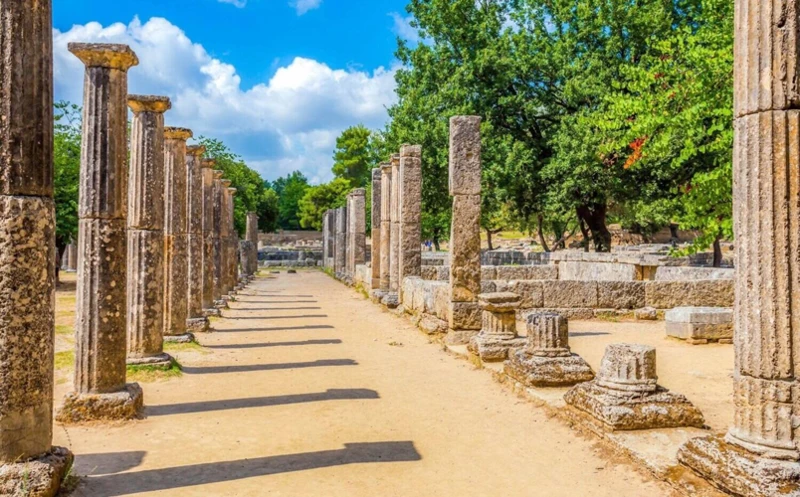
Olympia, located in the Peloponnese region of Greece, is an ancient site that served as a tribute to the gods and held great significance in ancient Greek culture. At the heart of Olympia stands the magnificent Temple of Zeus, one of the most celebrated structures of ancient Greece. This temple was dedicated to the king of the gods, Zeus, and housed a colossal statue of him created by the renowned sculptor Phidias. The statue, made of ivory and gold, was considered one of the Seven Wonders of the Ancient World. The architecture of the Temple of Zeus showcases the grandeur and power associated with the Greek gods, with its Doric columns and imposing pediments. Another notable structure in Olympia is the Stadium, where the ancient Olympic Games originated. The Stadium of Olympia was an immense open-air arena where athletes from all over Greece competed in events such as running, wrestling, and discus throwing. It could accommodate up to 40,000 spectators who gathered to witness the athletic prowess and pay homage to the gods. The remains of the stadium still stand today, allowing visitors to envision the triumphs and celebrations that took place in this historic venue. Olympia is a testament to the religious and athletic fervor of the ancient Greeks and continues to be a site of architectural and historical importance.
4.1 The Temple of Zeus: A Testament to Power and Beauty
Nestled in the sacred grounds of Olympia, the Temple of Zeus stands as a testament to power and beauty in ancient Greek architecture. Constructed in the 5th century BC, this colossal temple was dedicated to the mighty god Zeus, the king of the gods and the bringer of thunder and lightning. The Temple of Zeus was designed in the Doric order, showcasing its grandeur through its sheer scale and intricate details. Its outer colonnade consisted of 6 columns on the front and back, and 13 columns on each side, boasting a total of 104 columns. These columns, each standing approximately 17 meters tall, were skillfully carved with fluting and crowned with ornate Corinthian capitals. Inside the temple, a massive statue of Zeus, sculpted by the renowned artist Phidias, took center stage. This masterpiece of ancient Greek sculpture stood an astonishing 12 meters tall and was made of gold and ivory, radiating an aura of divine power and majesty. Sadly, the original temple and its awe-inspiring statue have been lost to the ravages of time, but their influence and significance endure. The Temple of Zeus at Olympia remains a symbol of architectural brilliance and a testament to the power and beauty of ancient Greek civilization.
4.2 The Stadium of Olympia: Witness to Athletic Triumphs
The Stadium of Olympia stands as a testament to the rich athletic history and tradition of ancient Greece. Located in the sanctuary of Olympia, this grand structure was the centerpiece of the Olympic Games, a prestigious sporting event held every four years to honor the gods. Constructed in the 4th century BC, the stadium could accommodate up to 45,000 spectators who eagerly gathered to witness the athletic prowess of Greek athletes. The stadium’s design was simple yet effective, featuring a long and narrow track with sloping banks on either side. The track, known as a stadion, measured about 192 meters in length and was comprised of compacted earth. Athletes, draped in garlands of olive leaves, would compete in various events such as running, wrestling, and chariot races, all vying for the coveted olive wreath and the glory it symbolized. The Stadium of Olympia was not merely a venue for entertainment, but a sacred space where physical prowess and the pursuit of excellence were celebrated. Today, this historic site serves as a timeless reminder of the ancient Olympic spirit and continues to inspire athletes and sports enthusiasts worldwide.
5. Minoan Architecture: Crete’s Ancient Legacy
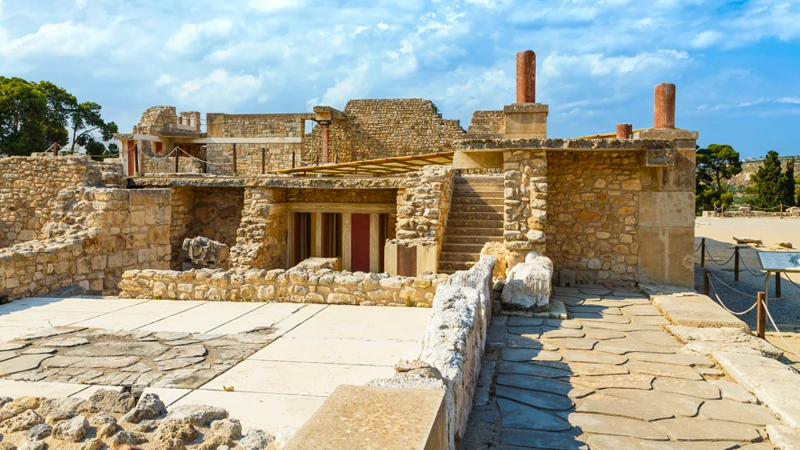
Minoan architecture, originating on the island of Crete, stands as a testament to the advanced civilization that flourished during the Bronze Age. The Minoans, known for their maritime trade and sophisticated culture, left behind a rich architectural legacy that continues to intrigue historians and archaeologists today. One of the most striking examples of Minoan architecture is the Palace of Knossos, a sprawling complex that served as the administrative and ceremonial center of the Minoan civilization. The palace features a labyrinthine layout, with interconnected corridors, courtyards, and rooms adorned with vibrant frescoes depicting scenes of daily life, religious rituals, and mythological motifs. The architectural style of the palace is characterized by intricately carved columns, spacious halls, light wells, and a remarkable use of natural light and ventilation. The Phaistos Disc, discovered in the palace of Phaistos, is an intriguing artifact that showcases the Minoans’ advanced knowledge of writing and language. Although its purpose and meaning remain a mystery, the circular clay tablet is adorned with a series of pictographs and symbols, reminiscent of a sophisticated script. Minoan architecture is a fascinating glimpse into the civilization that thrived on Crete thousands of years ago, demonstrating their mastery of architectural design and their reverence for art and culture.
5.1 The Palace of Knossos: Minoan Majesty Unearthed
The Palace of Knossos, located on the island of Crete, is an extraordinary testament to the majesty of Minoan architecture. This ancient palace complex, discovered by archaeologist Sir Arthur Evans in the early 20th century, offers a fascinating glimpse into the rich and advanced civilization of the Minoans. The palace is a sprawling labyrinthine structure, featuring grand courtyards, intricate wall frescoes, and an intricate system of chambers and staircases. The walls of the palace were adorned with vibrant murals depicting scenes of everyday life, mythical creatures, and religious ceremonies. The architecture of the Palace of Knossos demonstrates the remarkable engineering prowess of the Minoans, who were able to create multi-story buildings with complex layouts and advanced plumbing systems. The palace was not only a ruling center but also a hub of economic, political, and cultural activity. It is believed to have served as a royal residence, an administrative hub, and a religious center. Excavations have unearthed numerous artifacts, including pottery, jewelry, and tools, further illuminating the sophisticated lifestyle of the Minoans. The Palace of Knossos remains an awe-inspiring archaeological site, offering a fascinating glimpse into the splendor of Minoan civilization. It stands as a testament to the creativity and ingenuity of one of the ancient world’s most enigmatic cultures.
5.2 The Phaistos Disc: An Architectural Enigma
The Phaistos Disc is an ancient artifact that has puzzled archaeologists and linguists for decades. Discovered in 1908 in the ancient Minoan palace of Phaistos on the Greek island of Crete, this small, round clay disc is covered in a series of imprinted symbols on both sides. The incredibly complex nature of the symbols, arranged in a spiral pattern, has made it difficult to decipher the meaning and purpose of the disc. The symbols themselves appear to be hieroglyphic in nature, suggesting a form of writing. However, despite countless efforts and theories, the exact meaning of the symbols remains unknown. The Phaistos Disc has captured the imagination of scholars, sparking numerous debates and theories about its origin and purpose. Some believe that it is a script of an unknown language, while others propose that it could be a religious or magical object. Although the true purpose of the Phaistos Disc remains a mystery, its enigmatic nature continues to intrigue researchers and visitors alike. It serves as a reminder of the rich and enigmatic history of Minoan civilization and their contributions to ancient architecture and culture.
Conclusion

In conclusion, the architecture of ancient Greece stands as a testament to the ingenuity, creativity, and advanced engineering skills of the ancient Greeks. From the majestic Acropolis in Athens to the sacred sanctuary of Delphi and the awe-inspiring Olympia, each architectural marvel tells a unique story of cultural significance and artistic excellence. The meticulous attention to detail, harmonious proportions, and innovative design principles employed by Greek architects have had a profound influence on architectural styles throughout history. The legacy of Greek architecture can still be witnessed in modern-day buildings, and its impact continues to be felt across the globe. By exploring the rich architectural heritage of ancient Greece, we gain a deeper appreciation for the timeless beauty and enduring legacy of these remarkable structures. Whether it is the timeless perfection of the Parthenon or the elegant sophistication of the Temple of Apollo, the architectural wonders of ancient Greece continue to mesmerize and inspire us. They serve as a reminder of the remarkable achievements of the ancient Greeks and their enduring cultural legacy.
Frequently Asked Questions

1. What are the key characteristics of Greek architecture?
Greek architecture is characterized by its harmony, balance, and proportion. It emphasizes the use of columns, pediments, and friezes, showcasing a keen eye for symmetry and aesthetics.
2. What are the three orders of Greek architecture?
The three orders of Greek architecture are Doric, Ionic, and Corinthian. Each order has its distinctive features and proportions, contributing to the overall beauty and variety of Greek architectural styles.
3. What materials were commonly used in Greek architecture?
Marble, limestone, and sandstone were commonly used in Greek architecture. These materials were abundant in Greece and allowed for the creation of enduring structures with intricate details.
4. How did Greek architecture influence later architectural styles?
Greek architecture had a profound influence on later architectural styles, particularly during the Renaissance period. The principles of proportion and harmony found in Greek architecture served as a foundation for classical and neoclassical architectural movements.
5. What is the significance of the Parthenon?
The Parthenon, located on the Acropolis in Athens, is considered a symbol of perfection in Greek architecture. It exemplifies the Doric order and showcases the genius of ancient Greek engineering and craftsmanship.
6. How were the ancient Greek temples constructed?
Ancient Greek temples were constructed using a post-and-lintel system, where vertical columns supported horizontal beams. This architectural technique allowed for the creation of expansive temple structures with open interior spaces.
7. What is the role of the phaistos disc in Greek architecture?
The Phaistos Disc is an enigmatic artifact from Minoan architecture in Crete. It is a round clay disc covered in hieroglyphic symbols that have yet to be fully deciphered. While its exact purpose in Greek architecture remains uncertain, it is believed to have served a religious or administrative function.
8. How did Greek architects achieve perfect precision in their structures?
Greek architects employed meticulous planning and geometric principles to achieve precision in their structures. The use of mathematical formulas, such as the golden ratio, contributed to the harmonious proportions and balance seen in Greek architecture.
9. Which Greek architectural marvel is associated with the Oracle of Delphi?
The Temple of Apollo at Delphi is the most famous architectural structure associated with the Oracle of Delphi. It was believed to be a sacred place where the god Apollo communicated with priests and priestesses, providing prophecies and guidance.
10. What is the lasting legacy of Greek architecture?
The lasting legacy of Greek architecture is evident in the architectural styles and principles still used today. From government buildings to museums, countless structures around the world bear the influence of Greek architecture, showcasing its enduring beauty and impact.
References
Frequently Asked Questions

1. What were the main influences on ancient Greek architecture?
Ancient Greek architecture was influenced by various factors, including Egyptian, Mesopotamian, and Mycenaean influences. The Greeks also drew inspiration from their own cultural and artistic traditions.
2. How were the materials for Greek architecture sourced?
The Greeks used locally available materials such as limestone, marble, and clay to construct their architectural marvels. They often sourced these materials from nearby quarries, ensuring that they were readily available.
3. What is the significance of the columns in Greek architecture?
Columns played a vital role in Greek architecture. They provided structural support to buildings while also adding aesthetic appeal. The three main types of columns used were Doric, Ionic, and Corinthian, each with its distinctive style.
4. How were the architectural proportions determined in ancient Greece?
Ancient Greek architects used a system called the “Golden Ratio” or “Golden Mean” to determine the proportions of their buildings. This mathematical principle ensured balance and harmony in the design.
5. What made the Parthenon an architectural symbol of perfection?
The Parthenon, with its harmonious proportions, precise geometry, and intricate sculptures, is considered a symbol of architectural perfection. Its innovative design and use of optical refinements set it apart from other structures of its time.
6. How did the Oracle of Delphi influence the architecture in Delphi?
The Oracle of Delphi, a revered ancient priestess, played a significant role in shaping the architecture of Delphi. Temples and theaters were built to honor the gods and provide spaces for religious ceremonies and performances.
7. What is the significance of the Temple of Zeus in Olympia?
The Temple of Zeus in Olympia was one of the Seven Wonders of the Ancient World. It represented the power and might of the Greek gods and was home to the famous statue of Zeus, one of the largest sculptures of its time.
8. How did Minoan architecture differ from other ancient Greek architecture?
Minoan architecture, found on the island of Crete, had unique features such as bright colors, intricate frescoes, and complex layouts. It showcased the Minoan civilization’s sophistication and artistic prowess.
9. What do we know about the Phaistos Disc and its architectural significance?
The Phaistos Disc, a mysterious archaeological artifact found in the Palace of Phaistos, continues to perplex scholars. Its symbols and enigmatic inscriptions suggest a possible connection to Minoan architectural practices.
10. How did ancient Greek architecture influence contemporary architectural styles?
Ancient Greek architecture laid the foundation for many architectural principles still used today. Its emphasis on proportion, harmony, and aesthetics, as well as the use of columns and architectural orders, can be seen in various buildings around the world.







